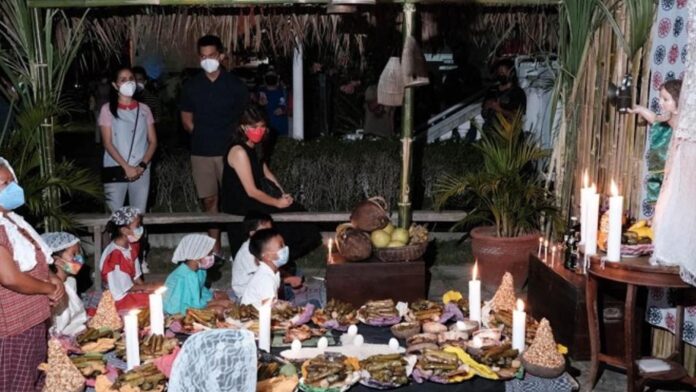Centuries-old tradition “Tumba” highlights Ilocos Norte’s halloween bash, enticing more tourists to visit up north.
Unique to the residents of Paoay, Tumba is an annual social ritual held every All Saints Day.
Like in the previous years, the town’s 10 districts representing its 31 villages come together at the heritage town plaza to build makeshift huts usually made of bamboo and other indigenous materials where they place their atang (offering) for those who have departed.
During the ritual, women elders wearing inabel, a traditional woven cloth of the Ilokano people, gather in front of the displayed offering with lighted candles, images of saints akin to an altar and recite the prayers and hymns for the dead, including those whose names or memories were already forgotten.
These prayers start early at 6 p.m. after everyone has made visits to the cemetery, and last until midnight.
The offerings at the altar include eggs, famous Ilokano cuisines, home-made alcoholic beverages, rolled tobaccos and even betel-nut chews.
The most distinct of these offerings is a rice cake called baduya, a sweetened fried glutinous pancake mainly produced for this occasion.
Visitors can also partake of the food offering in an act called agkararrua (meaning to be done on behalf of the spirits).
Cultural heritage worker Bernard Guerrero of Paoay town, in one of his written articles documenting the living and enduring traditions of his hometown, describes Tumba as the Philippines’ Dia de Muertos, or the Day of the Dead, in Mexico.
It portrays a celebration that is both solemn and jovial. It is meant to remember and honor the departed ones as well as to provide a form of neighborhood entertainment, he said.
Guerrero said that “while the town is famed for its rare Mardi Gras (Fat Tuesday) celebration called Guling-Guling, another unique ritual held every Nov. 1 called Tumba is less known.”
He said Tumba means “tomb” in Spanish.
“While there are no records to show when or why it started, Tumba is largely believed among locals to be at least 200 years old,” he said.
Guerrero theorized that Tumba may trace its origin back to its older counterpart in Mexico, from where the tradition found its way to and eventually gained popularity in Paoay during the Spanish colonial period.
To ensure that Tumba will be observed and preserved through the years, the municipal government of Paoay is allocating some funds annually to sponsor prizes for the best Tumba exhibit.
Prizes range from PHP10,000 to PHP15,000 for the top three winners, while consolation prize is PHP5,000.
While the Tumba concept or theme is left to the discretion of the participating village or district, the exhibit should still depict the culture, tradition, and values of the Paoayeños, giving emphasis on how the community celebrate All Saints Day.
“The tumba festival highlights our distinct and solemn ways of honoring the spirits of our departed love ones,” Paoay town mayor Sheilla Galano said in a media interview on Thursday as she enjoined everyone to visit the Tumba huts on Nov. 1 and experience a unique intangible heritage of the community which illustrates a strong connection of the people to their past. (PNA)






